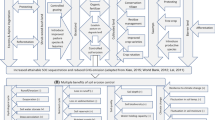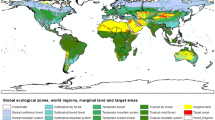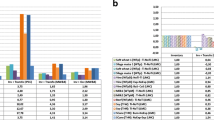Abstract
On the eve of the 15th climate negotiations conference in Copenhagen, the pressure to assess all climate mitigation options is mounting. In this study, a bio-physic model and a socio-economic model were designed and coupled to assess the carbon sequestration potential of agricultural intensification in Senegal. The biophysical model is a multiple linear regression, calibrated and tested on a dataset of long-term agricultural trials established in West Africa. The socio-economic model integrates both financial and environmental costs related to considered practice changes. Both models are spatially explicit and the resulting spatial patterns were computed and displayed over Senegal with a geographic information system. The national potential from large-scale intensification was assessed at 0.65–0.83 MtC. With regards to local-scaled intensification as local projects, the most profitable areas were identified in agricultural expansion regions (especially Casamance), while the areas that meet the current financial additionality criteria of the Clean Development Mechanism were located in the northern part of the Peanut Basin. Using the current relevant mode of carbon valuation (Certified Emission Reductions), environmental benefits are small compared to financial benefits. This picture is radically changed if “avoided deforestation”, a likely consequence of agricultural intensification, is accounted for as the greenhouse gases sink capacity of projects increases by an average of a hundred-fold over Senegal.
Similar content being viewed by others
References
ADEME, MIES (2007) Guide des facteurs d’émission—version 5.0. In: Bilan Carbone
Agbenin JO, Goladi JT (1997) Carbon, nitrogen and phosphorus dynamics under continuous cultivation as influenced by farmyard manure and inorganic fertilizers in the savanna of northern Nigeria. Agric Ecosyst Environ 63(1):17–24
Akaike H (1973) Information theory and an extension of the maximum likelihood principle. Paper presented at second international symposium on information theory, Budapest
Allard JL, Bertheau Y et al (1983) Ressources en résidus de récolte et potentialités pour le biogaz au Sénégal. Agron Trop 38(3):213–221
Aune JB, Lal R (1995) The tropical soil productivity calculator—a model for assessing effects of soil management on productivity. In: Lal R, Stewart BA (eds) Soil management: experimental basis for sustainability and environmental quality. CRC, Boca Raton
Badiane N (1993) Le statut organique d’un sol sableux de la zone Centre-Nord du Sénégal. Sciences Agronomiques. Nancy, Institut National Polytechnique de Lorraine
Badiane A, Faye A et al (2001) Use of compost and mineral fertilizers for millet production by farmers in the semiarid region of Senegal. Biol Agric Hortic 19(3):219–230
Baidu-Forson J, Bationo A (1992) An economic evaluation of a long-term experiment on phosphorus and manure amendments to sandy Sahelian soils: using a stochastic dominance model. Fertil Res 33:193–202
Bartel P (2004) Soil carbon sequestration and its role in economic development: a donor perspective. J Arid Environ 59(3):643–644
Bationo A, Buerkert A (2001) Soil organic management for sustainable land use in Sudano-Sahelian West Africa. Nutr Cycl Agroecosyst 61:131–142
Bationo A, Christianson CB et al (1993) The effect of crop residue and fertilizer use on pearl-millet yields in Niger. Fertil Res 34(3):251–258
Bationo A, Buerkert A et al (1995) A critical review of crop-residue use as soil amendment in the West African semi-arid tropics. In: Powell JM, Fernandez Rivera S, Williams TO, Renard C (eds) Livestock and sustainable nutrient cycling in mixed farming systems of sub-Saharan Africa. ILCA, Addis Ababa
Batjes NH (2001) Options for increasing carbon sequestration in West African soils: an exploratory study with special focus on Senegal. Land Degrad Dev 12(2):131–142
Bellamy PH, Loveland PJ et al (2005) Carbon losses from all soils across England and Wales 1978–2003. Nature 437(7056):245–248
Bernoux M, Arrouays D et al (1998) Bulk densities of Brazilian Amazon soils related to other soil properties. Soil Sci Soc Am J 62(3):743–749
Bernoux MFC et al (2006) Soil carbon sequestration. In: Roose E, Lal R, Barthès FCB, Stewart BA (eds) Erosion & carbon dynamics. CRC, Boca Raton
Boko M, Niang I et al (2007) Africa. In: Parry ML, Canziani OF, Palutikof JP, van der Linden PJ, Hanson CE (eds) Climate change 2007: impacts, adaptation and vulnerability. Contribution of working group II to the fourth assessment report of the intergovernmental panel on climate change. Cambridge University Press, Cambridge
Bosma R, Bengaly M et al (1995) Pour un système durable de production au Mali-Sud: accroître le rôle des ruminants dans le maintien de la matière organique des sols. In: Powell JM, Fernandez Rivera S, Williams TO, Renard C (eds) Livestock and sustainable nutrient cycling in mixed farming systems of sub-Saharan Africa. ILCA, Addis Ababa
Bosma RH, Bos M et al. (1999) The promising impact of ley introduction and herd expansion on soil organic matter content in southern Mali. Agric Syst 62(1):1–15
Breman H (1998) L’intensification agricole au Sahel: vouloir c’est pouvoir! In: Breman H (ed) L’intensification agricole au Sahel. Karthala, Paris
Cerri CEP, Paustian K et al (2004a) Combining soil C and N spatial variability and modeling approaches for measuring and monitoring soil carbon sequestration. Environ Manag 33(1):274–288
Cerri CEP, Paustian K et al (2004b) Modeling changes in soil organic matter in Amazon forest to pasture conversion with the Century model. Glob Chang Biol 10(5):815–832
Cerri CEP, Easter M et al (2007) Predicted soil organic carbon stocks and changes in the Brazilian Amazon between 2000 and 2030. Agric Ecosyst Environ 122(1):58–72
Christianson CB, Bationo A et al (1990) Fate and efficiency of N fertilizers applied to pearl millet in Niger. Plant Soil 125:221–231
CIRAD, GRET et al (2004) Mémento de l’Agronome. CIRAD, Paris
Cissé L (1986) Etude des effets d’apports de matière organique sur les bilans hydriques et minéraux et la production de mil et de l’arachide sur un sol sableux dégradé du Centre-Nord du Sénégal. Nancy, Institut National Polytechnique de Lorraine
COFACE (2006) Country risk outlook 2006. In: COFACE, East Windsor, NJ (USA)
Corbeels M, Scopel E et al (2006) Soil carbon storage potential of direct seeding mulch-based cropping systems in the Cerrados of Brazil. Glob Chang Biol 12:1773–1787
DAAC (2002) MODIS/Terra land cover type 96-Day L3 Global 1 km ISIN Grid. http://edcdaac.usgs.gov/modis/mod12q1.asp. Cited
Dataloy (2006) Dataloy website. http://www.dataloy.com/. Cited 18 May 2006
De Ridder N, Van Keulen H (1990) Somme aspects of the role of organic matter in sustainable intensified arable farming systems in the West African semi-arid-tropics (SAT). Fertil Res 26(1–3):299–310
Diarisso S (2004) Situation économique et sociale du Sénégal—Edition 2004. In: MEF/DPS, Dakar
Dugué P, Vall E et al (2004) Evolution des relations entre l’agriculture et l’élevage dans les savanes d’Afrique de l’Ouest et du Centre. Oléagineux Corps Gras Lipides 11(4):268–76
Easter M, Paustian K et al (2007) The GEFSOC soil carbon modelling system: a tool for conducting regional-scale soil carbon inventories and assessing the impacts of land use change on soil carbon. Agric Ecosyst Environ 122(1):13–25
Elberling B, Toure A et al (2003) Changes in soil organic matter following groundnut-millet cropping at three locations in semi-arid Senegal, West Africa. Agric Ecosyst Environ 96(1–3):37–47
Fall EHB (1998) Etude des impacts des activités du PST II sur l’environnement. In: Bank W. World Bank, Washington
FAO (2006) FAOSTAT data. http://faostat.fao.org/. Cited February 2006
Feller C (1995) La matière organique dans les sols tropicaux à argile 1:1—Recherche de compartiments organiques fonctionnels—Une approche granulométrique. Institut de géologie. Strasbourg, Université Louis Pasteur
Feller C, Ganry F et al (1981) Décomposition et humidification des résidus végétaux dans un agro-système tropical. I. Influence d’une fertilisation azotée (urée) et d’un amendement organique (compost) sur la répartition du carbone et de l’azote dans différents compartiments d’un sol sableux. II. Décomposition des résidus végétaux (compost) pendant une saison des pluies dans un sol sableux. Agron Trop 36(1):9–25
Feller C, Fritsch E et al (1991) Effet de la texture sur le stockage et la dynamique des matières organiques dans quelques sols ferrugineux et ferrallitiques (Afrique de l’Ouest, en particulier). Cahiers de l’ORSTOM, série Pédologie 26(1):25–36
Fernandes P (1999) Effet des modes de gestion des terres sur les termes et l’évolution de leur bilan organique et biologique: conséquences pour une production céréalière soutenue—Cas du Sénégal. Sciences Agronomiques. Nancy, Institut National Polytechnique de Lorraine
Fernandez-Rivera S, Williams TO et al (1995) Faecal excretion by ruminants and manure availability for crop production in semi-arid West Africa. In: Powell JM, Fernandez Rivera S, Williams TO, Renard C (eds) Livestock and sustainable nutrient cycling in mixed farming systems of sub-Saharan Africa. ILCA, Addis Ababa
Fontaine S, Barot S (2005) Size and functional diversity of microbe populations control plant persistence and long-term soil carbon accumulation. Ecol Lett 8(10):1075–1087
Henry M, Valentini R et al (2009) Soil carbon stocks in ecoregions of Africa. Biogeosciences Discussions 6:797–823
Hien E (2004) Dynamique du carbone dans un Acrisol ferrique du Centre Ouest Burkina: influence des pratiques culuturales sur le stock et la qualité de la matière organique. Ecole Doctorale Biologie Intégrative. Montpellier, Ecole Nationale Supérieure Agronomique de Montpellier
Hulme M, Doherty R et al (2001) African climate change: 1900–2100. Clim Res 17(2):145–168
Industries Chimiques du Sénégal (2006) ICS website. http://www.ics.sn/. Cited 12 Jun 2006
International Fertilizer Industry Association (2003) IFA website. http://www.fertilizer.org/ifa/. Cited 6 May 2006
IPCC (1996) Revised 1996 IPCC guidelines for national greenhouse gas inventories—workbook, vol. 2
IPCC (2006a) 2006 IPCC guidelines for national greenhouse gas inventories. In. IPCC
IPCC (2006b) The IPCC data distribution centre. http://ipcc-ddc.cru.uea.ac.uk/. Cited 5 May 2006
Isherwood KF (2000) Mineral fertilizer distribution and the environment. In. IFA and UNEP, Paris
Jones MJ (1971) The maintenance of soil organic matter under continuous cultivation at Samaru, Nigeria. J Agric Sci 77:473–482
Jones MJ (1973) The organic matter content of the savanna soils of West Africa. J Soil Sci 24(1): 42–53
Kante B (1997) Communication initiale du Sénégal à la Convention-Cadre des Nations-Unies sur les Changements Climatiques (CCNUCC). In: Ministère de la protection de la nature—Direction de l’environnement, Dakar
Kelly V, Diagana B et al (1996) Cash crop and foodgrain productivity in Senegal: historical view, new survey evidence, and policy implications. In: USAID
Kowal JM, Kassam AH (1978) Agricultural ecology of Savanna—a study of West Africa. Clarendon, Oxford
Le Fur A (2000) Espace agricole. La construction de l’espace sénégalais depuis l’indépendance, 1960–2000. In: Cormier M-C, Gueye C, Lericollais A, Seck SM (eds) Bondy, IRD
Liu S, Kaire M et al (2004) Impacts of land use and climate change on carbon dynamics in south-central Senegal. J Arid Environ 59(3):583–604
Manlay RJ, Chotte J-L et al (2002) Carbon, nitrogen and phosphorus allocation in agro-ecosystems of a West African savanna III. Plant and soil components under continuous cultivation. Agric Ecosyst Environ 88(3):249–269
Manlay RJ, Ickowicz A et al (2004) Spatial carbon, nitrogen and phosphorus budget in a village of the West African savanna—II. Element flows and functioning of a mixed-farming system. Agric Syst 79(1):83–107
McIntire J, Powell JM (1994) African semi-arid tropical agriculture cannot grow without external inputs. Paper presented at livestock and sustainable nutrient cycling in mixed farming systems of Sub-Saharan Africa. In: Proceedings of an international conference, Addis Ababa, Ethiopia
McIntire J, Powell JM (1995) African semi-arid tropical agriculture cannot grow without external inputs. In: Powell JM, Fernandez Rivera S, Williams TO, Renard C (eds) Livestock and sustainable nutrient cycling in mixed farming systems of sub-Saharan Africa. ILCA, Addis Ababa
Milne E, Al-Adamat R et al (2007) National and sub national assessments of soil organic carbon stocks and changes: the GEFSOC modelling system. Agric Ecosyst Environ 122(1):3–12
Ministère de l’Agriculture et de l’Hydraulique (2004) Rapport annuel 2004—Direction de l’élevage. In: Senegal. Ministère de l’Agriculture et de l’Hydraulique, Dakar
N’Guessan N (2003) Amélioration du transport de transit en Afrique de l’Ouest. In: Première session du comité intergouvernemental préparatoire de la conférence ministérielle internationale sur la coopération en transport de transit. UNCTAD, New York
Ogunwole JO, Ogunleye PO (2005) Influence of long-term application of organic and mineral fertilizers on quality of a savanna Alfisol. J Sustain Agric 26(3):5–14
Olsson L, Ardo J (2002) Soil carbon sequestration in degraded semiarid agro-ecosystems—perils and potentials. AMBIO 31(6):471–477
Palm CA, Giller KE et al (2001) Management of organic matter in the tropics: translating theory into practice. Nutr Cycl Agroecosyst 61:63–75
Pansu M, Gautheyrou J (2006) Handbook of soil analysis. Mineralogical, organic and inorganic methods. Springer, Berlin
Parton WJ, Schimel DS et al (1987) Analysis of factors controlling soil organic matter levels in Great Plains grasslands. Soil Sci Soc Am J 51(5):1173–1179
Parton W, Tappan G et al (2004) Ecological impact of historical and future land-use patterns in Senegal. J Arid Environ 59(3):605–623
Pichot J-P, Sedogo MP et al (1981) Evolution de la fertilité d’un sol ferrugineux tropical sous l’influence de fumures minérales et organiques. Agron Trop 36(2):122–133
Pieri C (1979) Etude de la composition de la solution d’un sol sableux cultivé au Sénégal à l’aide de capteurs en céramique poreuse. Agron Trop 34(1):9–22
Pieri C (1992) Fertility of soils—a future for farming in the West African savannah. Springer, Berlin
Pieri C (1995) Long term soil management experiments in semiarid francophone Africa. In: Lal R, Stewart BA (eds) Soil management. Experimental basis for sustainability and environmental quality = [Gestion du sol. Base expérimentale pour une durabilité et une qualité de l’environnement]. CRC Press, Boca Raton (Advances in Soil Science, ISSN 0176-9340)
Poulton P (1996) In: Powlson DS (ed) Evaluation of soil organic matter models using existing long-term datasets. Springer, Berlin
Powell JM, Williams TO (1995) An overview of mixed farming systems in sub-Saharan Africa. In: Powell JM, Fernandez Rivera S, Williams TO, Renard C (eds) Livestock and sustainable nutrient cycling in mixed farming systems of sub-Saharan Africa. ILCA, Addis Ababa
Rabot C (1984) Vingt années de successions de cultures dans la moitié Sud du Sénégal—impacts écologiques. Ecologie Tropicale. Montpellier, Université des sciences et techniques du Languedoc
Richard L, Djoulet B (1985) La fertilité des sols et son évolution en zone cotonnière du Tchad. In: Coton et fibres tropicales. Série documents, Etudes et synthèses = ISSN 0010-9711 n°6
Ringius L (2002) Soil carbon sequestration and the CDM: opportunities and challenges for Africa. Clim Change 54(4):471–495
Rosenzweig R, Forrister D (2006) State and trends of the carbon market 2006—summary. In: Carbon finance business. W. Bank. Natsource LLC, Washington
Sanchez PA (1997) Soil fertility replenishment in Africa: an investment in natural resource capital. In: Buresh RJ (ed) Replenishing soil fertility in Africa. American Society of Agronomy and Soil Science Society of America, Madison
Sankhayan PL, Hofstad O (2001) A village-level economic model of land clearing, grazing, and wood harvesting for sub-Saharan Africa: with a case study in southern Senegal. Ecol Econ 38(3):423–440
Santilli M, Moutinho P et al (2005) Tropical deforestation and the Kyoto Protocol. Clim Change 71(3):267–276
Sarr PL (1981) Analyse des effets induits par l’intensification des cultures sur quelques caractéristiques physico-chimiques d’un sol ferrugineux tropical du Sénégal (Nioro du Rip). Agronomie-Pédologie. Montpellier, Université des sciences et techniques du Languedoc
Schimel JP, Weintraub MN (2003) The implications of exoenzyme activity on microbial carbon and nitrogen limitation in soil: a theoretical model. Soil Biol Biochem 35(4):549–563
Schlesinger WH, Palmer Winkler J et al (2000) Soils and the global carbon cycle. In: Wigley TML, Schimel DS (eds) The carbon cycle. Cambridge University Press, Cambridge
Singh L, Balasubramanian V (1979) Effects of continuous fertilizer use on a ferruginous soil (haplustalf) in Nigeria. Exp Agric 15:257–265
Six J, Conant RT et al (2002) Stabilization mechanisms of soil organic matter: implications for C-saturation of soils. Plant Soil 241(2):155–176
Smaling E, Touré M et al (2006) Fertilizer use and the environment in Africa: friends of foes. Paper presented at African Fertilizer Summit, Abuja, Nigeria
Stancioff A, Staljanssens M et al (1986) Cartographie et télédétection des ressources de la république du Sénégal—Etude de la géologie, de l’hydrologie, des sols, de la végétation et des potentiels d’utilisation des sols. USAID, Brookings
StatSoft I (2006) Electronic statistics textbook. http://www.statsoft.com/textbook/stathome.html. Cited 21 Feb 2006
Tappan GG, Sall M et al (2004) Ecoregions and land cover trends in Senegal. J Environ 59(3):427–462
The World Bank (2008) Forest carbon partnership facility information memorandum—June 13, 2008, The World Bank
Tiessen H, Feller C et al (1998) Carbon sequestration and turnover in semiarid savannas and dry forest. Clim Change 40(1):105–117
Transparency International (2006) Corruption perceptions index 2005. http://www.transparency.org/policy_research/surveys_indices/cpi/2005. Cited 4 Apr 2006
Tschakert P (2004a) Carbon for farmers: assessing the potential for soil carbon sequestration in the Old Peanut Basin of Senegal. Clim Change 67(2–3):273–290
Tschakert P (2004b) The costs of soil carbon sequestration: an economic analysis for small-scale farming systems in Senegal. Agric Syst 81:227–253
UNCTAD (2000) Guide d’investissement au Mali. http://www.unctad.org/fr/docs/poiteiitm24.fr.pdf. Cited 28 Mar 2006
UNFCCC (2003) Modalities and procedures for afforestation and reforestation project activities under the clean development mechanism in the first commitment period of the Kyoto Protocol. 19CP9/FCCC/CP/2003/6/Add2. Bonn
UNFCCC (2005) Sixth compilation and synthesis of initial national communications from Parties not included in Annex I to the Convention. FCCC/SBI/2005/18/Add.2. United Nations Office at Geneva, Geneva
UNFCCC (2008) Report of the Conference of the Parties serving as the meeting of the Parties to the Kyoto Protocol on its third session, held in Bali from 3 to 15 December 2007. FCCC/KP/CMP/2007/9. United Nations Office at Geneva, Geneva
Vagen TG, Lal R et al (2005) Soil carbon sequestration in sub-Saharan Africa: a review. Land Degrad Dev 16(1):53–71
Vlek PLG (1990) The role of fertilizers in sustaining agriculture in sub-saharan Africa. Fertil Res 26(1–3):327–339
Vlek PLG, Rodriguez-Kuhl G et al (2004) Energy use and CO2 production in tropical agriculture and means and strategies for reduction or mitigation. Environ Dev Sustain 6:213–233
Wood EC, Tappan GG et al (2004) Understanding the drivers of agricultural land use change in south-central Senegal. J Arid Environ 59(3):565–582
Woomer PL, Tieszen LL et al (2004) Land use change and terrestrial carbon stocks in Senegal. J Arid Environ 59(3):625–642
Worldclim (2000) Précipitations totales annuelles au Sénégal. Catalogue: Coordination Régionale (France). ROSELT. Berkeley, Berkeley, University of California
Author information
Authors and Affiliations
Corresponding author
Rights and permissions
About this article
Cite this article
Bellassen, V., Manlay, R.J., Chéry, JP. et al. Multi-criteria spatialization of soil organic carbon sequestration potential from agricultural intensification in Senegal. Climatic Change 98, 213–243 (2010). https://doi.org/10.1007/s10584-009-9635-x
Received:
Accepted:
Published:
Issue Date:
DOI: https://doi.org/10.1007/s10584-009-9635-x




